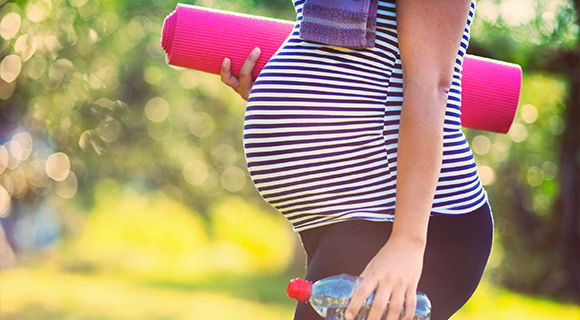
Exercise During Pregnancy
Benefits of being active
The days when pregnant women were told to rest all day are long gone. Today, we know that moderate exercise during pregnancy can help you feel your best and ease discomforts, such as backache and fatigue.
Tips for a safe workout
Exercise is a good warm-up for childbirth because the physical activity improves your circulation and energy for labor. Also, exercising during pregnancy can help you maintain muscle strength, avoid excess weight gain, and shed unwanted pounds after your baby is born. If you’re already physically active most days, great! If not, this is a good time to start. Begin slowly, build up gradually, and try to exercise at least 30 minutes per day.
Here are some tips for having a safe workout:
- Check with your doctor or nurse before starting any exercise routine.
- Whatever activity you choose, don’t overdo it. Listen to your body and rest if you feel tired. You should be able to carry on a conversation during any activity.
- Avoid dehydration by drinking extra water before, during, and after exercise.
- Eat plenty of food so that you don’t run low on glucose. Get tips on healthy eating during pregnancy.
- Do not exercise to lose weight. Read about the importance of weight gain during pregnancy.
- Avoid overheating. During hot weather, exercise indoors and (ideally) in an air-conditioned space.
Best exercises for moms-to-be
During your first trimester, you should be able to continue the same exercise routine if you’re having a normal, healthy pregnancy. Try for a combination of aerobic, strength, and flexibility exercises. In your second and third trimester, you may need to vary your routine slightly.
- Walking. It’s safe and easy for most women from the moment you find out you’re pregnant until the final weeks. Wear a pedometer to count your steps and motivate you to stay active. Remember to use the handrail when walking up or down stairs.
- Swimming or water aerobics. Both are gentle on your joints and provide a feeling of weightlessness (a welcome break in the later months of pregnancy).
- Stretching or yoga. Stretching eases back pain and helps you maintain flexibility. Look for classes or videos designed for pregnant women.
- Low-impact dance or aerobics. Moving to music is fun for both you and your growing baby. Stay balanced by avoiding jumps, kicks, leaps, and bouncing.
Exercises to prepare for birth
The muscles in your lower abdomen, lower back, and around the vagina (birth canal) come under great strain during pregnancy. During delivery, these same muscles must relax and stretch. In the event of a lengthy labor, increased endurance can be a real help. View samples of exercises and stretches to practice throughout your pregnancy to help prepare for childbirth.
Kegels: The other exercise
During pregnancy and delivery, the pelvic floor can become stretched and weak, leading to urine control problems after the baby is born. Kegel exercises help you strengthen your pelvic floor muscles.
Start doing Kegel exercises daily as soon as you become pregnant. Kegels can be done anytime, standing or sitting, and no one will even know. Here’s how:
- Firmly tighten the muscles around your vagina, as you would to stop urinating. (It’s not recommended to practice Kegel exercises while on the toilet because this may strain the pelvic floor muscles.)
- Hold tightly for as long as you can (8 to 10 seconds at the longest). Remember to keep breathing as you hold the muscles.
- Then slowly release the muscles and relax.
- Repeat 10 to 15 times, at least 3 times a day. Kegel exercises are only effective when done regularly.
Learn more about the benefits of Kegel exercises.
Activities to avoid
As you enter your second trimester, you may find that your achy joints, growing belly, and changing center of gravity make you unstable on your feet. During this time, you’ll probably need to make adjustments to your normal exercise routine.
Be sure to avoid these activities:
- bouncing, jumping, or movements where you could lose your balance, especially in the third trimester
- contact sports such as ice hockey, soccer, and basketball
- scuba diving
- exercise in high altitudes (above 6,000 feet)
- water or downhill skiing
- horseback or motorcycle riding
- after your fourth month, avoid anything that requires you to lie flat on your back (such as sit-ups and some yoga poses)
- avoid over-heating or extreme sweating, including avoiding saunas and hot whirlpools
Source: Adapted from copyrighted material of The Permanente Medical Group, Inc.
Reviewed by: Jeff Convissar, MD, November 2015
Additional Kaiser Permanente reviewers
© 2015 Kaiser Permanente





